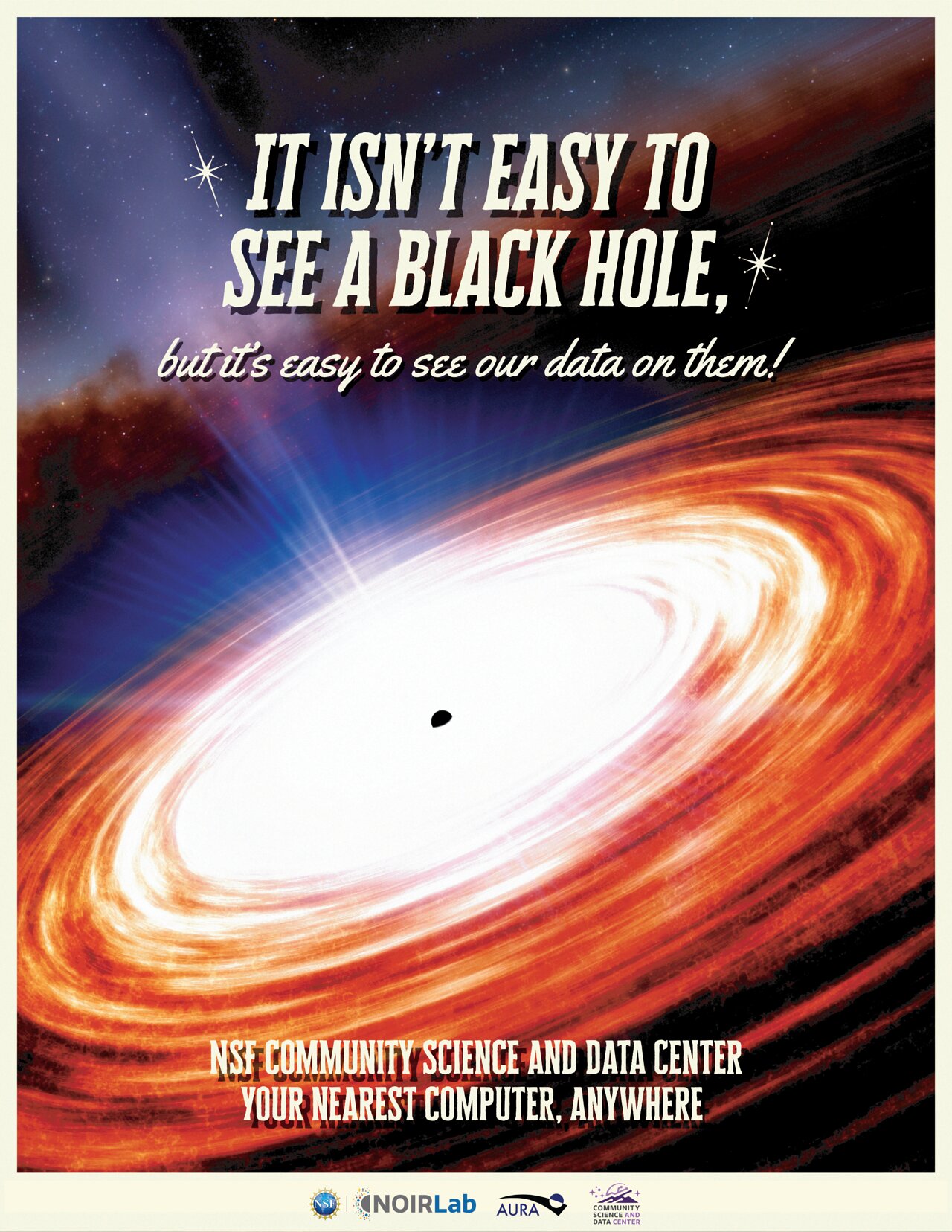Everything You Need to Know for Black Hole Week
As Black Hole Week approaches, NSF NOIRLab breaks down these mysterious structures by making singularities simple.
2 May 2025
It’s the beginning of May, meaning Black Hole Week is here again! To kick off the celebration, let's break down the basics of black holes, explore what makes them so intriguing, and find out how to learn more about them at home.
What is a black hole?
A black hole is an object in space that is so dense that its gravity becomes inescapable for anything that dares to cross its event horizon — the border within the hole where nothing inside can ever return.
When stars much larger than the mass of the Sun die, they explode into violent supernovae. Stars that are 20 times the mass of our Sun or larger collapse during supernovae into infinitely tiny points, forming black holes. These points, known as singularities, are where mass is crushed into infinite density. They cannot be seen directly, and no light can escape their grasp, meaning black holes are invisible.

If they’re invisible, how do we detect them?
As black holes interact with their environment, they release clues to their location. For example, a black hole that is described as active ‘eats’ material from nearby objects. As material from gas clouds and stars violently swirls closer to the event horizon, it heats up as a result of friction, creating a luminous glow and releasing waves of energy.
In 1933 physicist Karl Jansky identified strange radio waves emanating from the constellation Sagittarius, toward the center of the Milky Way Galaxy. This was the first clue that there was a black hole in our galactic neighborhood. Further research spanning decades confirmed that this mysterious source of energy truly is a black hole in the heart of the Milky Way. In the 1990s and early 2000s astronomers tracked the orbits of stars gravitationally bound to this mysterious source for 16 years. They determined from the stars’ motions that the mass of the Milky Way’s central object had to be over four million times that of our Sun. This mass was too large to be anything else besides a supermassive black hole that is known today as Sagittarius A*.
From similar studies, we know today that we are not unique in housing this structure: supermassive black holes exist at the center of most galaxies!
If they’re so common, what’s all the fuss about?
Black holes are fascinating because of how impossible they seem! Although Albert Einstein developed the mathematical theory behind black holes in the early 20th century, he didn’t believe they were physical objects. The knowledge that black holes are actual structures in space is fairly recent, making them an exciting and dynamic field of study for astronomers today.

Many amazing facets of black holes are investigated at NSF NOIRLab, including quasars. Quasars are supermassive black holes that have an incredible appetite for destruction. Their consumption emits enough energy to be thousands of times more luminous than our Milky Way. Additionally, quasars can eject incredible jets of energetic matter.
Earlier this year observations from the Gemini Near-Infrared Spectrograph (GNIRS), mounted on the Gemini North telescope, one half of the International Gemini Observatory, funded in part by the U.S. National Science Foundation (NSF) and operated by NSF NOIRlab, helped to discover the largest radio jet ever found in the early Universe. The quasar, named J1601+3102, was first identified using the international Low Frequency Array (LOFAR) Telescope, a network of radio telescopes throughout Europe. It formed when the Universe was only 9% of its current age and is 450 times the mass of our Sun. It has two jets stretching from the central black hole, spanning an incredible 200,000 light-years — twice the width of the Milky Way!

Black holes, although incredible on their own, also exist in binaries and merge. Last year, astronomers used archival data from the Gemini North telescope to find the heaviest black hole pair ever. When galaxies merge, their central black holes become gravitationally bound together in binaries. They slingshot around each other, with the black holes orbiting closer and closer until they merge into one. The pair detected by Gemini North are a mere 24 light-years apart, and have a combined mass 28 billion times that of the Sun.
Black hole studies continue to break astronomy records, revealing some of the strangest and most extreme behavior in the Universe. Curious to learn more about these structures? Check out NSF NOIRLab’s Teen Astronomy Café — To Go! Program for digital education pages to explore Black Holes and Black Hole Orbits.
Additionally, read more of our news related to black holes here.
See our collection of digital posters for Black Hole Week here.
Contacts
Nicole Kuchta
Communications Intern
NSF NOIRLab
Email: nicole.kuchta@noirlab.edu






